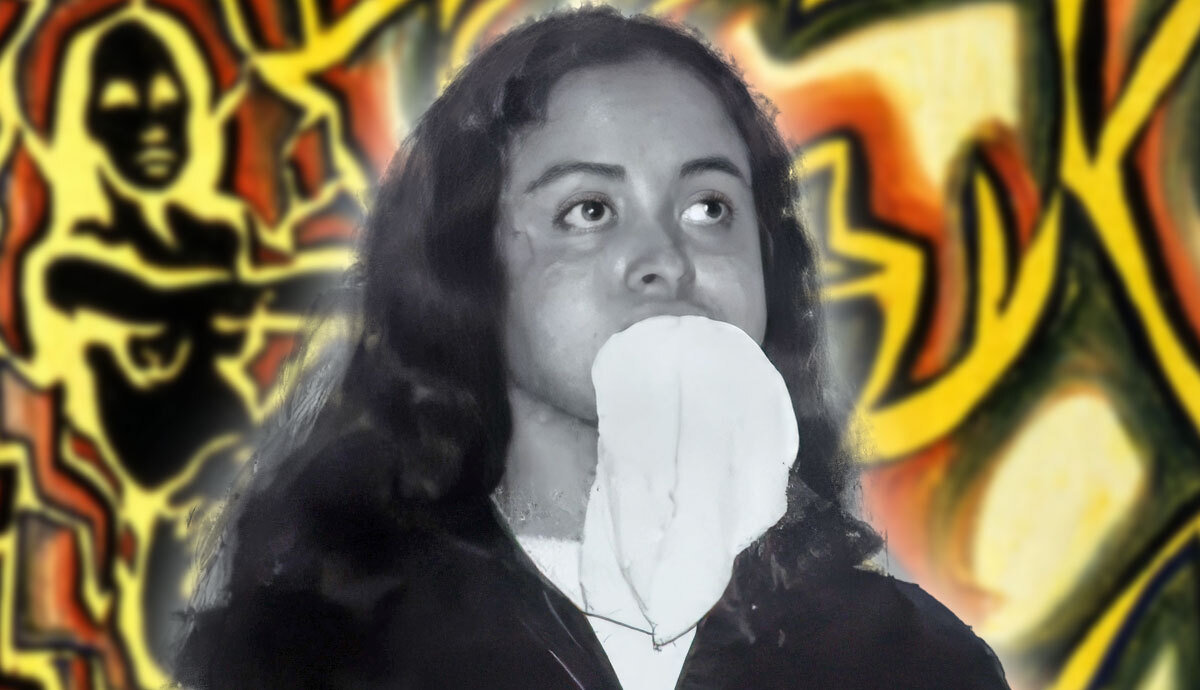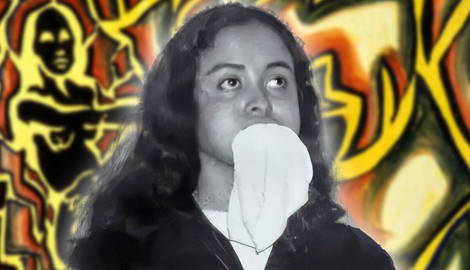
It is not easy to classify or grasp the versatile work of Adrian Piper. The work of the 75-year-old artist is determined by various art forms and materials. Adrian Piper initially worked in fine arts and sculpture. She was part of the first generation of conceptual artists and was strongly influenced by Sol LeWitt. In the 1960s and 70s, she attracted attention with her political performances, in which she revealed traditional sexist and racist patterns of behavior and discriminatory social codes. Later, she explicitly introduced political content into minimalism with her art. Her work has gone on to influence numerous artists, such as Kara Walker, and she remains an icon of artistic and political activism.
Yoga’s Influence On Adrian Piper’s Art

Adrian Piper’s works include works on paper, painting on canvas, drawings, silkscreen prints, photography, videos, and media installations. All of Piper’s works are influenced by yoga, meditation, and philosophy. Adrian Piper began teaching and practicing yoga and meditation around 1965, first as a self-study, and later she intensified her practice and knowledge with various teachers. Today, Adrian Piper is a devotee of Iyengar Yoga.
Philosophy And The APRA Foundation

Born in New York in September 1948, Adrian Piper first completed an artistic education, including studies in fine arts and sculpture at the School of Visual Arts in New York. Piper made a name for herself early on with her LSD paintings that she painted between 1965 and 1967. Discovered at that time by Robert Principe, the paintings are now part of the international canon of psychedelic art. After her artistic training and first exhibitions, Piper devoted herself to philosophical studies, which she completed in 1981 with a doctorate on the famous philosopher John Rawls. Later, the artist taught philosophy at universities – as a professor, she, in some cases, was the first African-American ever in this position.

Adrian Piper currently lives in Berlin, where she runs the APRA Foundation and the Adrian Piper Research Archive. The foundation had been established by Piper in 2002 after she was diagnosed with a shearing disease. The disease disappeared two years later and the archive with works of the artist herself in the sections Art, Philosophy, and Yoga is still available to those interested in research.
The Works of Adrian Piper

Adrian Piper is known for her extensive body of work, which mostly consists of Conceptual Art. Below is a selection of some of her most famous and interesting artworks:
1. Adrian Piper: Recessed Square (1967)

Recessed Square (1967) is a wall sculpture of wood and Masonite starkly painted black and white. Depending on the point of view, the sculpture reveals different levels and strictly geometrical shapes. This work by Adrian Piper is an example of the artist’s early Concept Artworks, which at the same time can be classified as being part of the Minimalist art movement.
Adrian Piper started creating Conceptual Art under the influence of Sol LeWitt. His approach of placing the idea of artwork above aesthetics and form strongly influenced the artist from the 1960s onwards. In An Artist’s Portrait of Piper, it says: “In 1968, she met and forged a friendship with Sol LeWitt, who connected her with the New York circle of conceptual artists. To this day, Adrian Piper follows Sol LeWitt’s conceptual art approach in her artworks.

The work Recessed Square (1967) is said to have been created in the same year in which Piper saw LeWitt’s work 46 Three-Part Variations on 3 Different Kinds of Cubes (1967 – 1971) for the first time. The author Isaiah Matthew Wooden explains in his essay Adrian Piper, Then and Again (2018), “The work [Recessed Square] betrays a clear interest in exploring matters of form, color, space, perspective and the possibilities and limitations of visual perception.” Questions of perception and the reflection of the self are recurring motifs in Adrian Piper’s work.
2. Adrian Piper: Catalysis (1970-73)

In the 1970s Adrian Piper’s art became increasingly political. In various performances, the artist explicitly addressed her multi-ethnic background and her womanhood with various actions in public space. Her most famous performances include the series Catalysis (1970 – 73) and The Mythic Being (1973). Piper’s artworks are often interpreted autobiographically. Catalysis (1970 – 73) and The Mythic Being (1973) are good examples of how the artist works with her personal experiences and biographical material (photos, diary entries, etc.), but at the same time uses techniques of alienation or disguise to create distance to her as a person.

In Catalysis I Adrian Piper challenges the perception of passengers on public transport by wearing clothes that she had previously soaked in a mixture of vinegar, eggs, milk, and cod liver oil for a week. For Catalysis IV, Piper again took the subway, this time in less conspicuous, conservative clothing, but with a white towel stuffed in her mouth. With The Mythic Being (1973 – 75), Adrian Piper created a male, stereotypical fictional figure. With a mustache and wig, she irritated passers-by on the street with her appearance and by repeating sentences from her diary in a continuous loop.

Author John P. Bowles interprets Piper’s performance of The Mythic Being in his book Adrian Piper: Race Gender and Embodiment as follows: “As a stereotype, The Mythic Being is the figure whites feared meeting and whom middle-class blacks did not want to be compared with – the naturalized justification for an unspoken racist ideology that casts blackness as masculine, heterosexual, and menial.”
3. Adrian Piper: Self-Portrait Exaggerating My Negroid Features (1981)

In the 1980s, Adrian Piper started to connect her meditation concept of the indexical present with interpersonal dynamics of racism and racial stereotypes. This is evident, for example, in the work Self-Portrait Exaggerating My Negroid Features (1981). As the title suggests, the pencil drawing on paper, in which she overdraws her own portrait, can be interpreted as an interrogation of her own identity and self. At the same time, it leads the viewer to question his or her own perception and possible stereotypes that might exist in the viewer’s mind. Piper said the goal of her work has always been “to induce a reaction or change in viewers.”
4. Adrian Piper: What It’s Like, What It Is #3 (1991)

While feminism, anti-racism, and perception persist in Adrian Piper’s work, the artist devoted herself to new media in the 1990s. In large-format multimedia works, she created installations that can be assigned to serial minimalism.
One of the best-known works in this field is What It’s Like, What It Is #3 (1991). This large-scale mixed-media installation addresses racist stereotypes. A video of the installation, which was shown as part of the exhibition Adrian Piper: A Synthesis of Intuitions, 1965 – 2016, shows how visitors to the exhibition experienced the large-scale installation. Like in an atrium, they look at small screens showing the portrait of a person of color from different perspectives. The voice of the person refutes existing clichés and confronts the visitors with them. In a statement on the installation, the artist explains: “I would like people to sit in the bleachers and think of where they are sitting as an amphitheater of the sort that one would sit in and watch Christians being devoured by the lions …” (see video).
5. Adrian Piper: Ashes To Ashes (1995)

In 1995, Adrian Piper withdrew one of her works from an important survey exhibition of early conceptual art in a museum, in protest both politically and personally against the sponsorship by tobacco manufacturer Philip Morris. As a replacement, the artist created Ashes to Ashes (1995), a photo-text work that is one of Piper’s most personal works. Ashes to Ashes tells the story of the death of both of the artist’s parents from smoking-related illnesses. This work consists of photographs from the family estate and an accompanying text, which is available in English and Italian.
This last work of the conceptual artist presented here is an explicitly autobiographical work, which only once again expands the spectrum of different art forms and media in the work of Adrian Piper. In this way, Piper illuminated the view of her private self for the viewer. The work can be seen as a complement to the many different reflections on the self and perception, but also as a complement to the artist’s political works. Last but not least, Ashes to Ashes can be viewed as part of the conceptual works of Adrian Piper.










